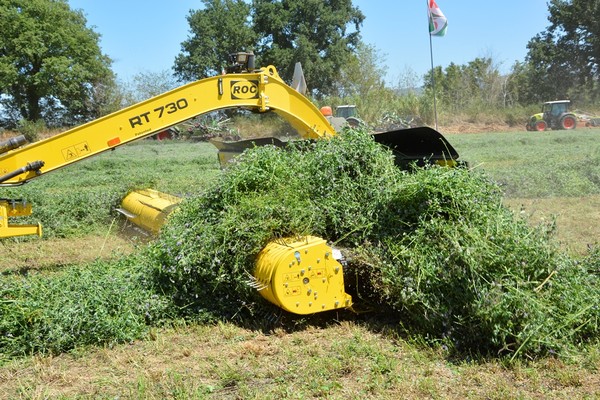
High quality forage using Roc belt mergers
Roc in the Province of Rimini is a brand name closely associated with belt mergers. Unlike traditional rakes which drag the crop on the ground to the window, the Roc mergers pick-up lifts the crop gently to a conveyer belt for transport and central or lateral deposit without any damage
The jewels in the crown of agricultural machinery manufacturer Roc in Poggio Torriana in the Rimini Province are their range of valid alternatives to traditional rakes. Roc belt mergers have been on the market for years and displayed all their power in the EIMA Show field demonstrations. The principle behind these forage mergers is their operation on the crop not only on the ground, as is the case with traditional rotary rakes, but gently load the product on a conveyer belt to sent it to central or lateral merger deposit with no damage. This extremely advantageous technological fine turned by the manufacturer provides numerous benefits, beginning with greater quality, less damage and hastening fresh crop growth. The Poggio Torriana company explained to Mondo Macchina/Machinery World that the sun drying of little alfalfa stalks, which support leaves, makes them extremely fragile. The pick-up of the crop using traditional rotary-rakes, especially in the absence of dew, means the little stalks are more subject to breaking. This causes the loss of leaves and the consequent loss of important proteins for animal feeding. On the other hand, by using the ROC system the crop is lifted and put gently on the belt to be transported and deposited centrally without any damage. Moreover, tests show that the Roc technology ensures a smaller quantity of earth and pebbles inside the windrow for achieving incomparable quality of the product and substantially greater aeration of the forage. With the belt, crop humidity is eliminated because it is totally lifted off the ground and deposited laterally on a clean surface for speedy and uniform drying. Furthermore, crop dragging with traditional rakes tends to leave a part of the product on the ground, especially if there are wheel-tracks or holes, but using the revolutionary continuous merger the crop is lifted on a belt and not dragged on the ground at all. Another important feature of this technology is the benefit of regrowth. In normal conditions, already after two or three days of harvesting some crop types like alfalfa produce fresh growth made up of small stalks and some leaves. Roc pointed that in these conditions, rotary-rakes tend often to break the small stalks, causing a delay in growth and therefore in harvesting, which means at the end of the season a delay of some weeks in the case of five crop cuttings. Yet another key issue with the belt merger is the fallout on costs of production. According to Roc, the duration of operation cycles with their mergers can be increased by 50% compared to traditional machinery. Thus the farm can reduce the number of tractors and mergers per hectare as well as the number of operators put to work in the fields. The Roc range extends to twelve machines differentiated mainly by work width from 3.8 meters for the little RT 380 up to 12.2 meters for the flagship RT 1220, said to be the biggest merger in the world. On the Deruta farm, the Rimini company fielded four machines, the entry level RT 380 named above, the mid-range RT 630 with double hydraulic rocker arm and the RT 730 also with double hydraulic rocker arm, and the RT 870 with work widths of 6.3, 7.3 and 8.7 meters.








